Industrial Complex
The Industrial Complex is one of the largest complexes for phosphate based fertilizers in the Middle East.
It is located at the Aqaba Gulf, some 18 km far from Aqaba city, and close to the Saudi-Jordanian borders. The purpose of establishing the Complex was to transform phosphate ore produced by the Company into a final product, hence, maximizing the benefits and increasing the value added. It is worth mentioning that the workforce at the Industrial Complex reaches 1128 of the top expertise.
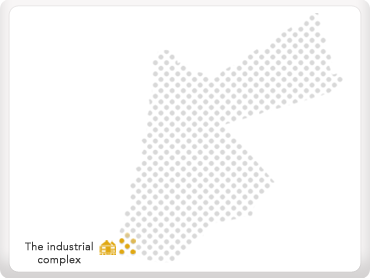
The Complex includes the following units:
Two Units for Fertilizers Production
Di-Ammonium Phosphate (DAP), as a fertilizer is produced at a daily capacity of 1500 tons in each of the two units, totaling 3000 tons daily. The produced fertilizer contains 18% nitrogen, and 46% phosphorus pent-oxide, which is soluble granular, that leads to easy absorption by the plants and vegetations. It can be used by the farming machinery for all crops and trees, and at either rain-fed or irrigated lands.
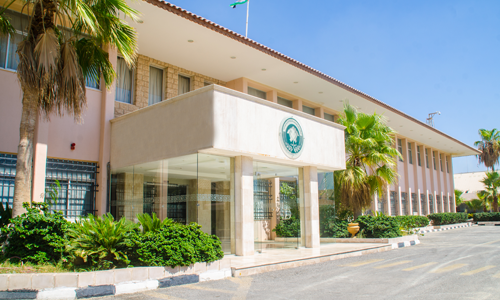
Ammonia is imported from Arab and foreign countries by ships, where it is pumped through a pipe with a diameter of 14 inches to a tank with a storage capacity of 30,000 tons, and a second tank with a storage capacity of 10,000. Ammonia temperature in the tanks is continuously kept at (-33 oC), and at one atmospheric pressure. To produce fertilizer, ammonia is pumped to a reactor, where it reacts with concentrated phosphoric acid to produce slurry, which is pumped to a fertilizer granulator to be mixed with the fertilizer returns. Additional ammonia is added to the granulator to reach the required mixtures. Using the hot gases produced by the burning fuel oil, Fertilizer is then dried, so its moisture content doesn’t exceed 1.5%. Fertilizer is conveyed to sieves to get the required size, and then to the storage silos. In the farms, fertilizer is used either directly or as an input to produce other fertilizers such as liquid and suspended compound fertilizers.
Phosphoric Acid Unit:
The plant was designed to produce 1310 tons daily of phosphoric acid solution of 28% concentration, depending on the type of the phosphate ore produced by the reaction of phosphate with the Industrial Complex produced sulfuric acid, using Paryon Wet Process. Phosphate is received by shipping trucks from the different mines, and downloaded at the phosphate station of the daily capacity of 6.500 tons. Phosphate is then conveyed through a conveyor belt to two storage silos with a storage capacity of 18,000 tons each. An open storage yard is also available with the ability to store 100,000 tons.
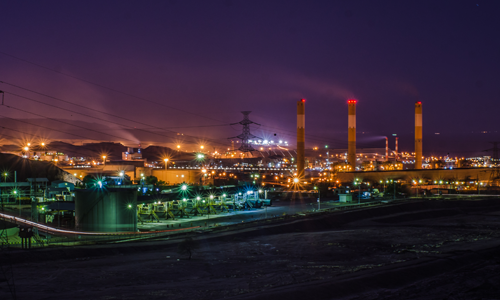
Phosphate is conveyed to the phosphate crusher, with the capacity of 200 tons per hour, where it is crushed to the size of less than 500 micron. Very fine phosphate will be reacting with sulfuric acid in a reactor of the capacity of 1,250 m3, in addition to the new two-chamber reactor of the capacity of 250 m3 each, with the existence of anti-acidic blenders, producing a mixture of low concentrated phosphoric acid and gypsum, where the mixture is pumped into three incubators, with a volume of 280 m3 each. The purpose of that last step is to increase the size of the gypsum crystals, and then filtering the mixture by (UCEGO Filter). Low concentrated phosphoric acid is then conveyed to special storage facilities, to increase its concentration at later stages. Gases resulting from the reaction, which include various fluoride based compounds, water vapor and carbon di-oxide gas are washed in absorption towers before they are released in the atmosphere. Increasing the concentration of the low concentrated phosphoric acid is done in heat-exchangers from 28% to 52% P2O2 using vacuum evaporation at three concentration steps. Additional purification to part of the acid is applied to have part of the final product for exporting, a minor part is sent to the local market, another part to Nippon Jordan Fertilizer Co., while the major part is used in producing fertilizers.

By-product gases from the concentration process are washed to get fluosilicic acid H2SiF6 at 20% concentration, which is an input for aluminum fluoride production
Fluosilicic acid is considered an intermediate product for multiple industries, of which are fertilizers, animal feed, chemical detergents, and also some food industries.
Sulfuric Acid Unit:
Sulfuric acid is produced in two units with 98.5% concentration, and a designed daily capacity of 2,500 tons for each unit. Sulfur used in producing sulfuric acid is imported from Arab neighboring countries, Iraq and Saudi Arabia, and from other foreign countries as Iran and Russia. It is stored in a storage facility of a capacity of 35,000 tons, in addition to an indoor storage yard that can take 18,000, and another storage yard outside the Complex, which can take 150,000 tons.
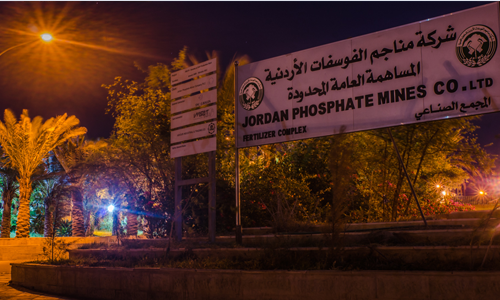
Sulfur is dragged from the stores by loaders and fed onto conveyor belts, where it gets melted in special pools by medium-pressure vapor, and adding some materials for purification. Liquid sulfur is stored in a heat-insulated storage of the capacity of 7,000 tons, at a temperature of 135 Celsius.
Liquid sulfur is pumped into a kiln at a temperature of 1000 degree Celsius, where it is burnt with the presence of dry atmospheric air to be transformed into sulfur dioxide (SO2) in the state of gas. As that chemical reaction is an exothermal one, the released temperature is then used in producing steam at high pressure (at 46 atmospheric pressure), which represents 75% of the produced steam in the Industrial Complex, and conveyed to the Facilities Unit. Carbon dioxide, in the state of gas is passed into a four-stage reactor containing Vanadium oxide (V2O5) as a catalyst, where it is transformed into sulfur trioxide (SO3).
That gas is then directed to absorption towers where it reacts with water producing sulfuric acid H2SO4 at a concentration of 98.5%, then, cooled down and stored in three tanks with the total capacity of about 36,000 tons.
Sulfuric acid is used in various industries such as water treatment, batteries, and as a solvent in various industries. It is also used in producing phosphoric acid.
Aluminum Fluoride (AlF3) Unit
This unit was formed to consume Fluosilicic acid H2SiF6 by-product from phosphoric acid concentration units, and harmful product to the environment. It is put to react with aluminum hydroxide Al(OH)3 and produce about 20 thousand tons annually
Aluminum hydroxide is imported from different sources, mainly Australia, India, Turkey, and France. It is imported in small ships, in shipments ranges between 12-7 thousand tons each. Shipments are transported by trucks to the aluminum hydroxide storage facility with the capacity of about 14 thousand tons.
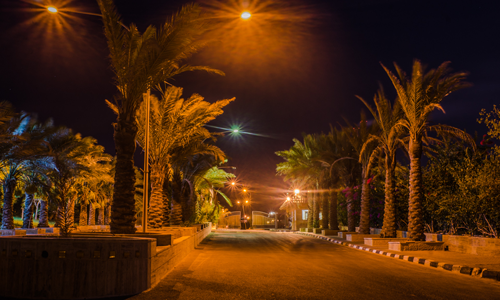
Aluminum hydroxide is pulled by a dragger to be stored in a silo for the wet hydroxide, dried by the exhaust gases of the Unit, stored in the dry hydroxide silo, and then, dragged to Reactors Feeder, where it feeds each of the 4 reactors with a specific quantity of aluminum hydroxide and Fluosilicic acid. By the completion of the reaction, the resulting mixture would be consisting of aluminum fluoride, the solvent, and silica sand. Silica sand is then removed by a filtration belt, and disposed onto the belt carrying gypsum from the Phosphoric Acid Unit.
Solvent aluminum fluoride is then separated by a filtration belt, dried through roasting in special equipment using burnt diesel, and packed according to demand in 25 kg, 50 kg, or 750 kg bags. Aluminum fluoride is used in extracting Aluminum from its ores by lowering the melting point in the electrical cells during the manufacturing process.
Material Handling Division:
 Industrial Port Unit consists of:
Industrial Port Unit consists of:
- Eastern Berth: It has ships loading equipment for solid and liquid materials, such as fertilizers produced at the Industrial Complex and Nippon Jordan Fertilizer Co., and the potash produced at the Arab Potash Co., and another equipment to unload liquid materials such as ammonia and fuel oil, and loading the phosphoric acid produced at the Industrial Complex, Indo Jordan Chemicals Co., and Jordan India Fertilizer Co.
- Western Berth: It has ships loading equipment for solid and liquid materials, and an equipment to unload the imported sulfur via the sea for the Industrial Complex, Indo Jordan Chemicals Co., and Jordan India Fertilizer Co. Aluminum hydroxide is unloaded here too
 Phosphate Unloading Unit: It consists of a station to unload the phosphate coming to the Industrial Complex, where a range of 240-300 trucks are unloaded daily. Phosphate is moved to the storage facility of the phosphoric acid plant. It also contains a dust suction system for the dust resulting from the unloading operation.
Phosphate Unloading Unit: It consists of a station to unload the phosphate coming to the Industrial Complex, where a range of 240-300 trucks are unloaded daily. Phosphate is moved to the storage facility of the phosphoric acid plant. It also contains a dust suction system for the dust resulting from the unloading operation.
 Packing Unit: It consists of two bags packing production lines of weights of 50 kg and 1000 kg for fertilizers coming from the fertilizer store, to be up loaded on trucks and exporting to local and external markets. Also packing bulk fertilizers in containers.
Packing Unit: It consists of two bags packing production lines of weights of 50 kg and 1000 kg for fertilizers coming from the fertilizer store, to be up loaded on trucks and exporting to local and external markets. Also packing bulk fertilizers in containers.
 Weighbridges: They are used to weigh imported and exported materials from and to the Industrial Complex.
Weighbridges: They are used to weigh imported and exported materials from and to the Industrial Complex.
General Facilities Unit:
This unit provides the general services required for the operation of the production units. Services such as electrical power, all types of high, medium, and low pressure steam, water of all types: industrial, desalinated, cooling, potable, and water for fire extinguishing. Also providing the required types of air; the air required for the industrial processes, and for the high precision instruments, as there are special standards for each of the aforementioned types.
Water treatment undergoes various stages; chemicals are added in order to get special water with specific standards to stop corrosion and leaving no sediments in the used equipment.

Two boilers are available, with the capacity of 100 tons per hour each to produce steam at 405 ºC and 43 Atmospheric Pressure, which is classified as high pressure steam. That steam is sent to two turbines, with the capacity of 22 Mega Watt/hour each to produce the electrical power needed for the production units, Nippon Jordan Fertilizer Co., and some other small industries in the surrounding. The surplus of the electrical power is sold to the Electrical Power Co. In some cases, minor quantities of electrical power are received from the Electrical Power Co.
There are two stand-by power generators run, automatically, by diesel for the emergency of power cut-off, each of the capacity of 2.2 Mega Watt/hour.
A water pumping station with a capacity of 24,000 m3/hour pumps sea water, after treating it with sodium hypochlorite that was produced by treating sea water. The purpose of this water is cooling. This water is dumped back to the sea as pure water, with no chemicals added in order to keep the marine environment pollution free.
Also, there are treated wastewater ponds, with rubber lining, to be reused in the Phosphoric Acid Unit, in addition to reusing treated wastewater coming from Aqaba city.